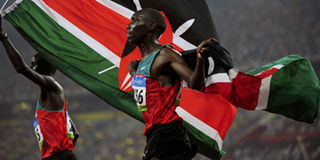Village in hilly Marakwet that’s the goldmine of steeplechasers

Men's 3,000 steeplechase winner Brimin Kiprop Kipruto of Kenya (L) and third classified compatriot Richard Kipkemboi Mateelong celebrate after the men's 3,000 steeplechase athletics final in the National Stadium at the Beijing 2008 Olympic Games. Photo/REUTERS
What you need to know:
- Trekking to school for long distances daily gave the race world conquerors
Kenya’s four steeplechasers in the Berlin World Championships in Athletics come from a village that has dotted the global charts for nearly two decades.
Komora, which is in the heart of the hilly Marakwet District, has lived up to its billing as a seedbed of elite steeplechasers as they reside within a 5 kilometre-radius of the village.
Olympic and World champions have established a strong empire in Kenya’s number one speciality, the 3,000 metres steeplechase.
World and Olympic champion Brimin Kipruto and former Olympic champion Ezekiel Kemboi, All Africa record holder Ruth Bosibori and Kenya’s first World Junior champion Gladys Kemboi will be in the hunt for medals in the German capital next week.
So keen has been their enthusiasm to shatter every record in sight that it has made the world wonder what makes them claim a bigger slice of the glory. Their victory has been so consistent that it demands a closer look at their training programmes.
Steeplechase coach Boniface Tiren, who has trained most of the runners in Kapcherop Club near Komora, says the terrain and the high altitude have been quite helpful.
“We have been recruiting steeplechasers right from the grassroots level during December holidays. And since steeplechase is a technical event, we need to strategise well to ensure our athletics scale the heights of fame. There has not been a (Kenyan) national team without our steeplechasers,” said Tiren.
Inspired by legends
Inspired by legendary track stars, it was William Mutwol, the 1992 Barcelona Olympics bronze medallist, who laid the foundation for the Komora fort with a brilliant 8:10.74.
“I was encouraged to take up running by impressive performances of Kipchoge Keino. I used to hear over the radio about him. We are fortunate to reside in a high altitude region and our training programme is fitting too. Our cultural values uphold high discipline, which counts more than the talent,” said Mutwol.
In his footsteps was Moses Kiptanui, the three-time World champion, who was the first man to dip under the eight-minute mark as he strolled to an impressive 7:56.16 in Cologne, Germany, in 1997.
Former World champion Moses Kiptanui, also a star from the area, said local residents trek long distances in the hilly district.
“Children are forced to walk long distances to school because such facilities are few and brilliant performers have become role models.
I have no doubt in our steeplechase team to Berlin as they can overcome the French challenge. At least we can win 1-2 places or even sweep the podium,” said Kiptanui.
Reuben Kosgei broke his reigns as he won the Sydney 2000 Games mantle in 8:21.43 before romping to an amazing 7:57.29 in Brussels, Belgium, in 2001.
Kenyan-turned-Qatari Shaheen Saif Saaeed of Qatar – formerly Stephen Cherono – trained in the area while a student at Marakwet Boys High SChool. The world record holder went to Brussels in 2004 and posted the 7:53.63 time.
The 2004 Athens Olympics champion, Ezekiel Kemboi (8:05.81), improved his personal best in May at the Doha Super Grand Prix to 7:58.85 against compatriot Brimin Kipruto, who boasts a 8:02.89 best time.
Kipruto will lead the Kenyan assault in the water jump contest in Berlin. He will be up against his neighbours Ezekiel Kemboi and another Kenyan-turned-Qatari, Thomas Kipyatich. Bosibori, who is married to the 2006 World Junior and 2007 All Africa Games champion Willy Komen, fights it out with Gladys Kemboi in the women’s race, an event former Athletics Kenya head coach Julius Kirwa puts little hopes in.
Unfortunately, Komen picked up an injury early this season.
Set such a tradition
“I am happy our senior runners managed to set such a tradition. The onus is on us to maintain good performances. In Berlin we need to improve on our speed to counter the Russians,” said Gladys Kemboi, a mother of one.
Kipyatich, the 2004 national schools champion, was beaten in the semi-finals in the Beijing Olympic Games. He and Uganda’s Benjamin Kiplagat are among steeplechasers from the area who changed their citizenship.
Moses Kemboi featured in the 2006 IAAF Grand Prix while Beatrice Rop, also from the region, settled for fourth place in the 2006 Beijing World Junior Championships. Kemboi, who basks in the Military Games title, saw an ankle injury sideline him from Berlin.
He is married to Gladys Kemboi.
Silas Kosgei and Bisluke Korir bagged silver and bronze at the 2005 World Youth Championships in Ostrava, Czech Republic.
At the 2004 Olympics, Ezekiel Kemboi and Brimin Kipruto won gold and silver, respectively, as their neighbour Ronald Kipchumba grabbed the 2004 World Junior gold in Cresseto, Italy. Kipchumba broke a 20-year-old record in Canada in 2003.
Led his neighbour
Former World Junior champions Mike Kipyego and Raymond Yator reigned between 2000 and 2003.
Kipyego led his neighbour David Chemweno in the World Junior in Santiago, Chile, in 2000 for gold and silver, respectively. Philip Simbolei, another star from the goldmine, won the bronze medal at the inaugural World Youth Championships in Bydgoszcz, Poland, in 1999.
This was barely a year after John Kosgei, a versatile runner with the best techniques in clearing the barriers, lifted the Commonwealth Games title in Kuala Lumbur, Malaysia.
In the Sydney Olympics finals, Yator stumbled after he had led the laps up to the water jump, which enabled his neighbour Reuben Kosgei to carry the gold in 8:21.43.
Despite having recorded brilliant shows at outdoor meetings, Nathan Naibei, Moses Kemboi and Silas Kosgei’s brother Thomas Kiplita have never ran in the national jersey.



